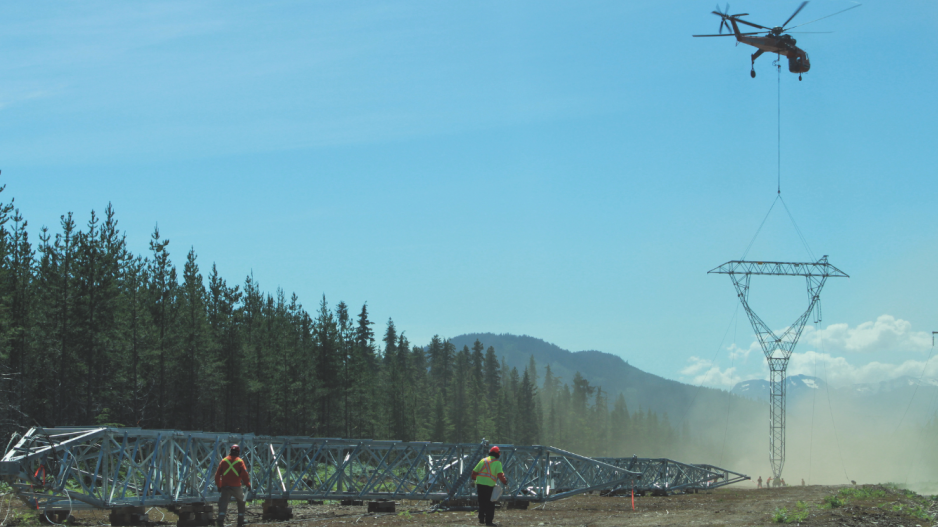A critical part of an $860 million gas processing plant that Veresen Midstream recently announced it wants to build near Dawson Creek is a recently completed BC Hydro transmission line to provide power.
Now two more electrification projects are being planned to provide power for the natural gas industry in northeastern B.C., and B.C. Energy and Mines Minister Bill Bennett says they just can’t wait for a lengthy review by the BC Utilities Commission (BCUC).
“My understanding, right now, is that if I do not direct the BCUC to allow these projects to go ahead, that we may lose some of the interest on the part of the gas companies,” Bennett said. “They just don’t feel they can wait for a long BCUC process.”
The two projects would provide hydro power to the natural gas industry, which otherwise needs gas-fired plants to generate the power it needs for gas processing facilities, compressors and pipelines.
The companies backing the new proposals say the projects would reduce carbon dioxide emissions and provide new industrial power customers for BC Hydro, which has lost industrial sales thanks to a slowdown in mining and the closure of the Howe Sound Pulp and Paper mill.
The Peace River Regional District (PRRD), however, objects to the projects being excluded from a BCUC review, which would take about a year or more to conduct.
“Our concern, of course, is once again the avoidance of going through the process that is in place to examine these things,” said Karen Goodings, Area B director for the PRRD. “It’s almost as though this is another excuse for building Site C.”
The North Montney Power Supply (NMPS) project is a joint venture between Atco Electric, an Alberta power company, and Progress Energy, whose natural gas assets in the Montney would supply Petronas’ Pacific NorthWest LNG plant with gas.
Atco would build 40 kilometres of transmission line and 65 kilometres of distribution lines running from the G.M. Shrum Generating Station at W.A.C. Bennett Dam to the Pink Mountain area. It would have a capacity of 100 megawatts.
The other proposal, called the Peace Region Electricity Supply, is a BC Hydro initiative that would provide up to 230 MW of power. It too would supply power to industrial customers in the gas sector in the Peace region.
Combined, the two projects could have a potential power draw of about 30% of the generating capacity of Site C dam (1,100 MW).
David Austin, a lawyer specializing in energy projects, said he thinks a good case can be made for excluding the Progress-Atco project from the BCUC process, but not BC Hydro’s Peace project.
“The proposed Atco line that would service Progress natural gas field is not something to be publicly reviewed by the public utilities commission,” Austin said. “It’s private money going into a private transmission system to serve a private customer.
“The BC Hydro project should be reviewed by the BC Utilities Commission because it’s public money going into a public project.”
Veresen Midstream’s gas processing plant near Dawson Creek will be powered by the Dawson Creek-Chetwynd Area Transmission line, which is expected to come in over budget.
BC Hydro’s Peace project is an extension of that line, which was subject to a BCUC review. According to its application to the utilities commission, BC Hydro estimated the cost of the Dawson Creek-Chetwynd line at $222 million but budgeted $257 million. However, according to BC Hydro’s 2014-15 annual report, that project is now estimated to come in at $296 million.
If Bennett decides to direct the BC Hydro project to bypass the commission, the industrial customers will be required to provide financial guarantees that would cover potential overruns, the minister said.
“If we decide we’re going to direct Hydro to build it, part of that direction will include getting commitment of security from the upstream customers so that the ratepayers’ interest is not put at risk,” Bennett said.
BC Hydro’s sales of electricity to industrial customers, which account for about a third of all power sales in the province, have been falling – something that could pose a problem for the corporation’s $8.8 billion Site C dam project. The pulp and paper sector draws about half the power it did 10 years ago. The closure of pulp mills such as Howe Sound Pulp and Paper has resulted in a 15% decline in power sales to industry over the past decade.
Should industrial demand for power continue to fall, it raises the spectre of Site C dam coming online with a power surplus that is even higher than originally anticipated. The Peace and NMPS projects could use a lot of that surplus power – about 30% of Site C’s generating capacity.
Electrifying the gas fields of the Peace region would generate industrial sales equivalent to two to four large pulp mills, according to the ministry. Electrification would also help companies like Progress Energy develop a liquefied natural gas industry while meeting new carbon emissions caps.
Bennett said the Atco-Progress transmission project would be equal to removing 80,000 cars from the road – about 400 tonnes of carbon dioxide per year. The BC Hydro project would result in a one-million-tonne reduction.
Bennett said he fears lost economic opportunities if BC Hydro’s Peace project is subjected to a BCUC review.
“The fact of the matter is if it goes through a BCUC process, we may end up losing some of our customers,” he said. We wouldn’t lose all of them. So my decision is going to have to be based on: ‘How can we get maximum number of gas company customers hooked up on these two transmission lines?"
@nbennett_biv




